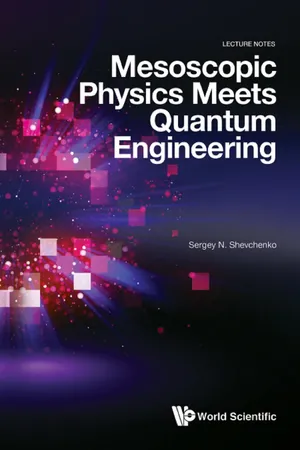
- 176 pages
- English
- ePUB (mobile friendly)
- Available on iOS & Android
Mesoscopic Physics meets Quantum Engineering
About This Book
Quantum mechanics was initially constructed to describe objects on atomic and subatomic scales. However, in the last decades, quantum mechanics has been revisited and its use extended to the study and description of macroscopic distinct states. This is accomplished by modeling basic objects of mesoscopic physics, such as superconducting quantum circuits and low-dimensional structures derived from a two-dimensional electronic gas. In recent years, these devices support the study of fundamental systems such as a two-level quantum system, or qubit, as an object for manipulations and applications. This book will provide an introduction to quantum computation and quantum information, based on quantum physics, solid-state theory, and theory of computing. We will become familiar with this important field and explore how it is inseparably linked to basic notions of physics such as superposition, entanglement, and quantum dynamics. Then we will consider superconducting and mesoscopic systems, as well as a series of phenomena, where important are the spectra quantization, interference, and charge discreteness.
This book derives its content from a lecture course designed for graduate students and postdocs who are acquainted with quantum mechanics and statistical physics. In particular, it was developed together with the lecture series taught to 5th year students of the Department of Physics and Technology in V N Karazin Kharkiv National University.
Contents:
- Quantum Engineering
- Superposition, Entanglement, and Quantum Computation
- Quantum Mechanics of Qubits
- Superconducting Quantum Circuits
- Normal Quantum Circuits
- Circuit Quantum Electrodynamics
- Conclusion
- Bibliography
- Index
Readership: Graduate students and researchers in the field.Quantum Engineering;Quantum Dynamical Effects;Two-Level System;Qubit;Superconducting Qubits;Quantum Dots;Quantum Wires;Landau-Zener-Stuckelberg-Majorana Interference;Josephson Effect;Rabi Oscillations;Multi-Photon Excitations;Circuit QED0 Key Features:
- Adapted for delivering lectures: this contains relatively simple derivations and schemes prepared for easy reproducing on the blackboard. The presentation is self-sufficient and does not require any other source. Book contains elements which supplement standard courses like Quantum Mechanics and Statistical Physics
- Covers several modern subfields, such as Quantum Dynamics, Superconducting and Semiconducting Qubits, Low-Dimensional Structures, Circuit Quantum Electrodynamics, with which every modern student in Physics should be familiarized
- The introductory material is useful for professionals as well, since it presents concise and important features in the emergent field of quantum engineering
Frequently asked questions
Information
Chapter 1
SUPERPOSITION, ENTANGLEMENT, AND QUANTUM COMPUTATION
1.1.Quantum computers
Table of contents
- Cover Page
- Title Page
- Copyright Page
- Abstract
- Contents
- 0. Quantum Engineering
- 1. Superposition, Entanglement, and Quantum Computation
- 2. Quantum Mechanics of Qubits
- 3. Superconducting Quantum Circuits
- 4. Normal Quantum Circuits
- 5. Circuit Quantum Electrodynamics
- Bibliography
- Index